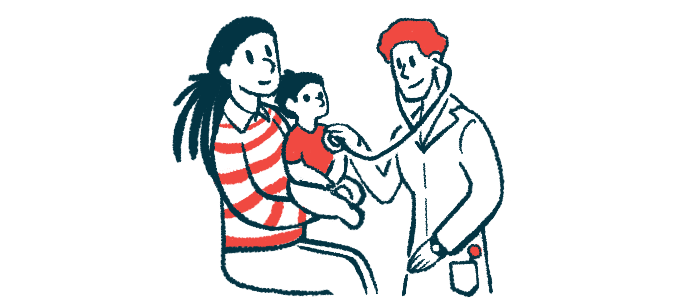Despite long-term Myozyme, many health problems seen in IOPD kids
Small German study reviewed use of ERT, sold in US as Lumizyme, from infancy

Children with classic infantile-onset Pompe disease (IOPD), who were first treated as infants with Myozyme (alglucosidase alfa) — sold as Lumizyme in the U.S. — continue to experience heart, breathing, and cognitive deficits, as well as motor problems, despite long-term use of the older therapy, a small German study showed.
According to researchers, the most important finding was that many patients treated with this early enzyme replacement therapy (ERT) — approved more than a decade ago — experienced a decline in motor and breathing functions after an initial improvement. These declines negatively impact the physical quality of life of these patients.
“The findings of this study can be valuable as comparative data when evaluating the impact of newer treatment strategies,” the researchers wrote.
The team stressed that “the aim of this study is not to denigrate ERT with [Myozyme], but to describe the long-term outcome of the first IOPD generation receiving ERT.”
The study, “Long-Term Outcome of Infantile Onset Pompe Disease Patients Treated with Enzyme Replacement Therapy – Data from a German-Austrian Cohort,” was published in the Journal of Neuromuscular Diseases.
Study tracking 15 patients 1st treated with Myozyme as babies
In Pompe disease, mutations in the GAA gene result in a deficiency in the GAA enzyme that breaks down glycogen, a complex sugar molecule involved in energy storage. Without this enzyme activity, glycogen remains intact and builds up to toxic levels in tissues, particularly in muscles.
Different types of Pompe are classified based on the onset of symptoms — from muscle weakness to breathing difficulties — that can emerge either early or later in life. When the disease is seen in the first year of life, it’s known as infantile-onset. Patients who have symptoms emerge later in life are said to have late-onset disease.
Myozyme is an enzyme replacement therapy, or ERT for short, that was approved for Pompe in Europe in 2006. The treatment provides a lab-made form of the human GAA enzyme via regular intravenous or into-the-vein infusions. It was approved in the U.S. in May 2010.
However, while it’s been more than 10 years since the therapy’s approval, knowledge about the long-term outcomes of IOPD patients treated with Myozyme is still limited.
To learn more, a team of scientists in Germany, Austria, and Switzerland assessed the clinical status of 15 IOPD patients, ages 7 and older, who began treatment with the ERT at a median age of 5 months. Six of the patients were female.
Their age at symptom onset ranged from birth to 5 months, with an IOPD diagnosis made between 1 and 31 months, or nearly 2.6 years, of age. Before ERT, all of the infants had heart abnormalities and elevated creatinine kinase, a sign of muscle damage. Eleven of the infants (73%) had failed to reach any motor milestone. Four (27%) could turn around; six (40%) were tube-fed.
Among the infants, 12 began ERT at a 20 mg/kg starting dose every two weeks, while two were given doses of 20 mg/kg weekly, and one received 40 mg/kg weekly.
Follow-up data showed all children gained motor skills and learned to crawl and sit independently. Seven (47%) could walk between 1.2 and 2.2 years of age. Two lost walking ability, at ages 3 and 7.
About half of patients remained free of breathing support at most recent exam
At the most recent examinations, the patients ranged in age from 7 to nearly 20. Six individuals (40%) were sitting without support, while four (27%) had lost all motor skills and had become tetraplegic, or unable to move their upper and lower limbs. Researchers noted that the onset of tetraplegia occurred between 2.1 and 8.3 years of age. Most patients (87%) showed joint contractures, or a tightening of the muscles, tendons, and joints.
Cardiac hypertrophy, the thickening of the heart’s left ventricle, a lower chamber, was normalized in all patients except for one, who developed thickening of both the right and left ventricles at the age of about 6.
About half of the patients (53%) were free of any breathing support. Two individuals (13%) needed non-invasive ventilation during sleep, and five (33%) were ventilated via a hole in the windpipe, called a tracheostomy. No relationship was found between the age when ERT began and the need for breathing support or a loss of walking ability.
Oral feeding was reported in eight children (53%), including a child who was temporarily tube-fed. A total of eight patients underwent a procedure to install a feeding tube via the abdomen. Three children (20%) were underweight for their age, and another three were severely underweight.
Hearing loss was detected in eight of 12 patients, with hearing aids used by four. All patients showed facial muscle weakness and/or speech problems, and 13 (86.7%) had drooping of the eyelids. Vision problems were detected in eight individuals (53%).
One patient completed secondary school, and four (27%) attended regular school, three of whom needed physical support. Five (33.3%) attended a special school for physically disabled students, one patient (7%) was homeschooled online, and the remaining four (27%) did not attend school.
Among the 11 patients who underwent cognitive testing, four (36%) showed normal development, one (9%) had mild developmental delay, and six (55%) were intellectually disabled.
Based on MRI scans, six of 12 patients had lesions in the brain’s white matter, two with enlarged ventricles or cavities within the brain, and one with abnormalities in a brain region called the basal ganglia.
Thanks to the experience gained with immunomodulation [therapies like Myozyme] … and the development of next-generation [treatments], it can be assumed that the outcome of IOPD patients receiving ERT … now and in the future will be better.
A total of 14 parents completed the Short-Form 36-Health Survey for health-related quality of life on behalf of their children. Scores for physical health were lower than normal for 13 patients (93%). Other impairments included general health perception and social functioning. Emotional role function, vitality, and psychological well-being were above the normal mean.
Finally, three patients who remained on a standard dose (20 mg/kg every two weeks) of Myozyme lost their previously acquired motor abilities and required breathing support. Two of four patients who received an intermediate dose (20 mg/kg weekly or 40 mg/kg every two weeks) lost motor and breathing abilities. In comparison, motor and breathing function remained intact for seven patients treated with the high dose (40 mg/kg weekly).
“Substantial motor, cardiac, respiratory, and cognitive deficits are frequent in IOPD long-term survivors who started ERT before 2016,” the researchers concluded.
The researchers said these new data may help to assess the impact of next-generation ERTs and other new treatments, such as gene therapies.
“Thanks to the experience gained with immunomodulation [therapies like Myozyme] … and the development of next-generation [treatments], it can be assumed that the outcome of IOPD patients receiving ERT … now and in the future will be better,” the team wrote.








